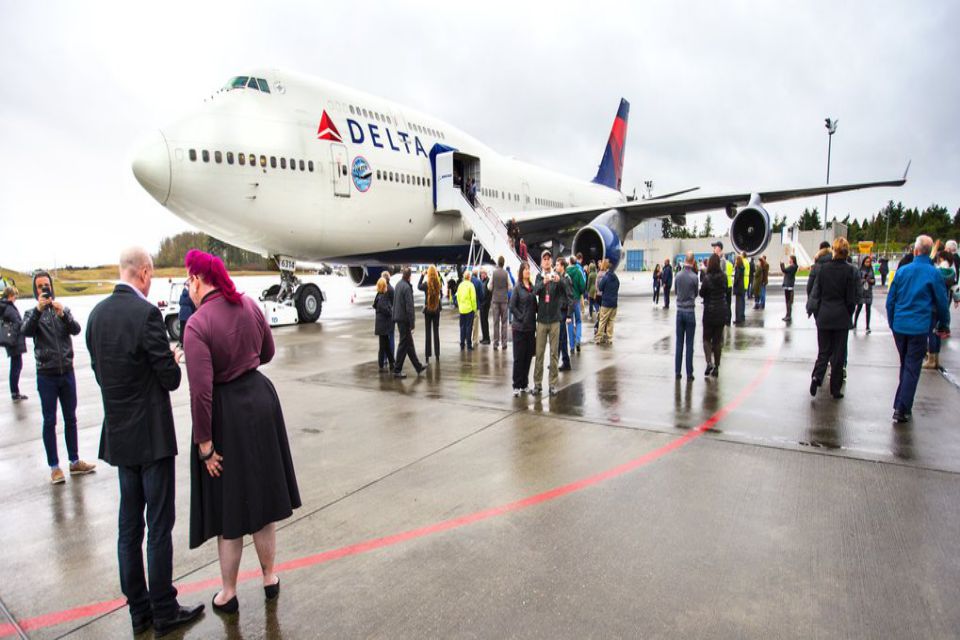Aviation
Retirement of Boeing 747 from Delta’s fleet marks end of era

SEOUL – Nearly 400 customers, crew and employees said a formal farewell to Delta’s 747-400 on Sunday morning to commemorate the Queen of the Skies’ retirement from Delta revenue flights.
“The B747-400 has been an integral part of Delta’s entire fleet for the last three decades, especially on trans-Pacific routes,” said Andrew Kim, Delta’s Director – Sales, Korea. “Today’s flight, “Now Delta has introduced, for its next-generation main aircraft for the trans-Pacific, the newer A350, which is already active on the Incheon-Detroit route on select days. With the retirement of the 747, the route now offers the latest aircraft with premium products and service everyday” Andrew added.
The ceremony honored two distinguished 747-400 captains for their contribution to aviation history and thanked customers for sharing the decades with Delta.
“I started flying for Delta Air Lines in 1976. All of those years have put me in the fortunate position of being the Senior 747 Captain at Delta and given me the incredible honor of flying today’s flight along with this great crew,” said Capt. Brian Hollingsworth. “The 747 is the most iconic aircraft ever built, and an aircraft that every pilot dreams of flying. Actually, I have been married to a former flight attendant for 40 years now, and she will be greeting me when we arrive in Detroit because today is my last trip. I am retiring after 42 years at Delta.”
After thanking his fellow crew members, Hollingsworth welcomed Capt. Rusty Bliss, one of Delta’s most senior captains and a 747 check airman instructor.
Ship 6310, was manufactured in 1990, has flown approximately 64 million miles and is retiring after 27 years of service, in favor of safer, more comfortable, more reliable and more efficient modes of transportation for our passengers.”

Aviation
Boeing, Antonov to Collaborate on Defense Projects

– MOU represents Boeing’s commitment to work with Ukrainian industry
– Includes exploring opportunities for collaborating on in-country support of Unmanned Aerial Systems
A Memorandum of Understanding was signed today by Boeing and Antonov Company to investigate potential collaboration on defense-related projects.
“We’re happy to keep collaborating with the Antonov Company to help Ukraine’s economic development and expansion,” stated Ted Colbert, CEO and president of Boeing Defence, Space, & Security.
Airbus and the Antonov An-225: The Best Partnership:Click here
“This agreement demonstrates our ongoing efforts to find more opportunities to work with Ukrainian industry, which was underscored by our signing of the Ukrainian Defence Industry Compact earlier this year.”
The areas of potential collaboration identified in the agreement consist of training, logistical support and overhaul services for tactical Unmanned Aerial Systems utilized by the Ukrainian Armed Forces, which includes the ScanEagle. In addition, the companies will also explore opportunities for Antonov to provide engineering support to Boeing.
The six largest cargo aircraft ever built in the aviation industry:Click here
“A strong, innovative, and efficient defense industry is key to sustainable economic development and national security, and we are extremely excited to collaborate with Boeing,” said Ievhen Gavrylov, CEO of Antonov Company.
This agreement brings a whole new level of opportunity to implement the latest and most effective solutions – in addition to the possibility of future projects with Boeing in the aerospace and defense industry.”
-

 Travel1 week ago
Travel1 week agoAir India to Expand US Operations with Three New Routes After a Decade
-

 Travel2 weeks ago
Travel2 weeks agoWhy We Should Avoid These Stamps in a Passport
-

 Airlines1 month ago
Airlines1 month agoInvestigations Reveal Fake Chinese Titanium in Boeing and Airbus Jets
-

 Tech4 weeks ago
Tech4 weeks agoChina’s CATL Plans 1,800-Mile Electric Plane Launch by 2027
-

 Airport3 days ago
Airport3 days agoTop 10 Largest Airports in the World by Size
-

 Aerospace4 weeks ago
Aerospace4 weeks agoChina’s Fighter Jets Turn Wings into Autonomous Drones
-

 Airlines4 days ago
Airlines4 days agoAir India Rolls Out A350s for Delhi-New York JFK and Newark Routes
-

 Defence3 weeks ago
Defence3 weeks agoBoeing Enhances Chinook with New Engines and Block II Upgrades at $96 Million








